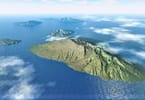When the guns opened up in Europe 99 years ago, on 28th July 1914, their thunder signaling the start of the Great War, later known as World War I, the German cruiser Koenigsberg on 31st of July slipped out of the harbor of Dar es Salaam. She left port before war was officially declared by Britain, managing to escape the watchful eyes of the British, a lapse they lived to rue in the early years of the war, which unfolded on and off the shores of East Africa with as much a vengeance as in the European theater.
Across East Africa were the war cemeteries given a clean-up for the occasion, not that it would be necessary really since the Commonwealth War Graves Commission keeps these locations in ship shape throughout the year, not just ahead of commemorations like the start or the end of the respective wars.
Just over a year ago I visited the Taita Taveta area, the one location where indeed trenches, fortifications and bunkers dug into the earth can still be found until today, while the other area where the German and Allied Forces clashed, in the highlands around Kisii, nothing much of substance can now be found.
The World War I cemeteries in Voi, Maktau and Taveta are today a permanent reminder, though few actually are able to put the history properly together, of what played out in this part of Kenya, in a war where over 100.000 Africans died in the service of their colonial masters, fighting for causes which were not theirs and for which they got little if any recognition but a few monuments across the region, yet not a single war cemetery where today’s generation of Kenyans and Tanzanians could pay their respects to their fallen ancestors.
A few days ago I sat with Kenya’s tourism gurus at KTB, discussing how the centenary commemorations of World War I, which will extend to all parts of Europe where troops fought, but also to the East African battlefields, where Jan Smuts’ and von Lettow-Vorbeck’s boys shed their blood, can be used to restore some of the fortifications, trenches and positions like high up on Salaita Hill or Mashoti, to create an open air monument, honoring those who died in action and a permanent reminder for today’s generation that bloody conflict is best avoided.
Since my visit a year ago has James Willson Esq. published his book “Guerillas of Tsavo” (www.guerillasoftsavo.com) , in which he describes the various engagements, on Mile 27, at Mashoti and other parts of what today is Tsavo West and the Taita Taveta border region with Tanzania and of course the attempt of a final showdown at Salaita Hill, from which the Germans withdrew overnight, sneaked back into Tanganyika to fight another day, a day which lasted in fact until the end of the war even though they had lost control of Tanganyika when the Koenigsberg in the Rufiji Delta and the Graf von Goetzen on Lake Tanganyika were scuttled by their crews. Von Lettow-Vorbeck never was defeated in the field though surrendered immediately when the news of the Armistice in Europe were broken to him in late 1918.
And now commences the countdown to the centenary commemoration and memorials of what was first known as the Great War, and time will tell just how prepared Kenya will be to showcase these locations to the war historians and war buffs who will no doubt flock to Kenya to see Battlefield East Africa where perhaps their forefathers fought, pay their respects, trace their steps and the German and Allied troop movements on the maps and in the field and see the giant Baobab tree not far from Taveta which got shot up by Allied forces, thinking a sniper had taken position in the hollow of it.
Time to remember, time to once again look at the past and the history of pre-independence Kenya and of other colonies and protectorates in the region back then, what role they played and how the European war played out in our part of the world.
WHAT TO TAKE AWAY FROM THIS ARTICLE:
- And now commences the countdown to the centenary commemoration and memorials of what was first known as the Great War, and time will tell just how prepared Kenya will be to showcase these locations to the war historians and war buffs who will no doubt flock to Kenya to see Battlefield East Africa where perhaps their forefathers fought, pay their respects, trace their steps and the German and Allied troop movements on the maps and in the field and see the giant Baobab tree not far from Taveta which got shot up by Allied forces, thinking a sniper had taken position in the hollow of it.
- Com) , in which he describes the various engagements, on Mile 27, at Mashoti and other parts of what today is Tsavo West and the Taita Taveta border region with Tanzania and of course the attempt of a final showdown at Salaita Hill, from which the Germans withdrew overnight, sneaked back into Tanganyika to fight another day, a day which lasted in fact until the end of the war even though they had lost control of Tanganyika when the Koenigsberg in the Rufiji Delta and the Graf von Goetzen on Lake Tanganyika were scuttled by their crews.
- A few days ago I sat with Kenya's tourism gurus at KTB, discussing how the centenary commemorations of World War I, which will extend to all parts of Europe where troops fought, but also to the East African battlefields, where Jan Smuts' and von Lettow-Vorbeck's boys shed their blood, can be used to restore some of the fortifications, trenches and positions like high up on Salaita Hill or Mashoti, to create an open air monument, honoring those who died in action and a permanent reminder for today's generation that bloody conflict is best avoided.






















